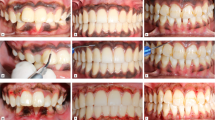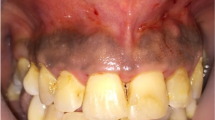Abstract
Perioral hyperpigmentation is commonplace in practice; it can be a physiological finding or reflect a systemic life-threatening disease or syndromes, this is treated with different types of application. A 20-year-old female with isolated perioral hyperpigmentation and treatment of this lesion with an erbium:YAG laser is shown. There were no other signs and symptoms in this patient. Another pathological finding could not be determined during examinations, laboratory tests and radiological studies. The erbium:YAG laser was applied to the hyperpigmented area. There was no complication after laser application and an aesthetically successful result with patient satisfaction was achieved in both early and late terms. According to our knowledge this is the first report, which has described the isolated idiopathic type of perioral hyperpigmentation.




Similar content being viewed by others
References
Lenane P, Powell FC (2000) Oral pigmentation. J Eur Acad Dermatol Venereol 14:448–465
Grover R, Richman PI, Gault DT (1998) Predicting the outcome of laser treatment for pigmented lesions. Br J Plast Surg 51:51–56
Weinstein C (1999) Erbium laser resurfacing: current concepts. Plast Reconstr Surg 103:602–616
Alster TS (1999) Clinical and histologic evaluation of six erbium:YAG lasers for cutaneous resurfacing. Lasers Surg Med 24:87–92
Kwon SD, Kye YC (2000) Treatment of scars with a pulsed Er:YAG laser. J Cutan Laser Ther 2:27–33
Sawcer D, Lee HR, Lowe NJ (1999) Lasers and adjunctive treatments for facial scars: a review. J Cutan Laser Ther 1:77–85
McGregor JM, Eisen AZ, Wolff K. (eds) (1999) Fitzpatrick’s dermatology in general medicine, vol 1, 5th edn. McGraw-Hill, New York, pp1555–1561
High AS (1989) Oral disorders of pigmentation. Postgrad Update 14:1297–1301
Voron DA, Hatfield HH, Kalkhoff RK (1976) Multiple lentigines syndrome: case report and review of the literature. Am J Med 14:447–453
Cook CA, Lund BA, Carney JA (1987) Mucocutaneous pigmented spots and oral myxomas: the oral manifestations of the complex of myxomas, spotty pigmentation, and endocrine overactivity. Oral Surg Oral Med Oral Pathol 63:175–183
Dereure O (2001) Drug-induced skin pigmentation. Epidemiology, diagnosis and treatment. Am J Clin Dermatol 2:253–262
Kleinegger CL, Hammond HL, Finkelstein MW (2000) Oral mucosal hyperpigmentation secondary to antimalarial drug therapy. Oral Surg Oral Med Oral Pathol Oral Radiol Endod 90:189–94
Poland A, Glover E (1977) Chlorinated biphenyl induction or aryl hydrocarbon hydrolase activity. A study of the structure activity relationships. Mol Pharmacol 13:924
Goldman PJ (1973) Severe acute chloracne, a mass intoxication by 2,3,6,7 tetrachlorodibenzo-dioxin. Hautarzt 24:149
Bartolome B, Cordoba S, Nieto S, Fernandez-Herrera J, Garcia-Diez A (1999) Acute arsenic poisoning: clinical and histopathological features. Br J Dermatol 141:1106–1109
Laughon SK, Shinn LL, Nunley JR (2000) Melanonychia and mucocutaneous hyperpigmentation due to hydroxyurea use in an HIV-infected patient. Int J Dermatol 39:928–931
Peihong J, Zhiyong L, Rengui C, Jian W (2001) Early congenital syphilis. Int J Dermatol 40:198–202
Stratigos AJ, Dover JS (2000) Overview of lasers and their properties. Dermatol Therapy 13 (1):2–16
Lapiere K, Ostertag J, Kar T, Krekels GA (2002) Neonate with a giant congenital naevus: new treatment option with the erbium:YAG laser. Br J Plast Surg 55(5):440
Jasin ME (2002) Achieving superior resurfacing results with the erbium:YAG laser. Arch Facial Plast Surg 4(4):262–266
Teikemeier G, Goldberg DJ (1997) Skin resurfacing with the erbium:YAG laser. Dermatol Surg 23:685
Kauffman R, Hibst R (1996) Pulse erbium:YAG ablation in cutaneous surgery. Lasers Surg Med 19:324
Dover JS (1999) Roundtable discussion on laser skin resurfacing. Dermatol Surg 25(8):639
Author information
Authors and Affiliations
Corresponding author
Rights and permissions
About this article
Cite this article
Copcu, E., Tugay, C. & Tugay, G. Idiopathic isolated perioral hyperpigmentation and treatment with the erbium:YAG laser. Lasers Med Sci 18, 223–226 (2004). https://doi.org/10.1007/s10103-003-0276-4
Received:
Accepted:
Published:
Issue Date:
DOI: https://doi.org/10.1007/s10103-003-0276-4




